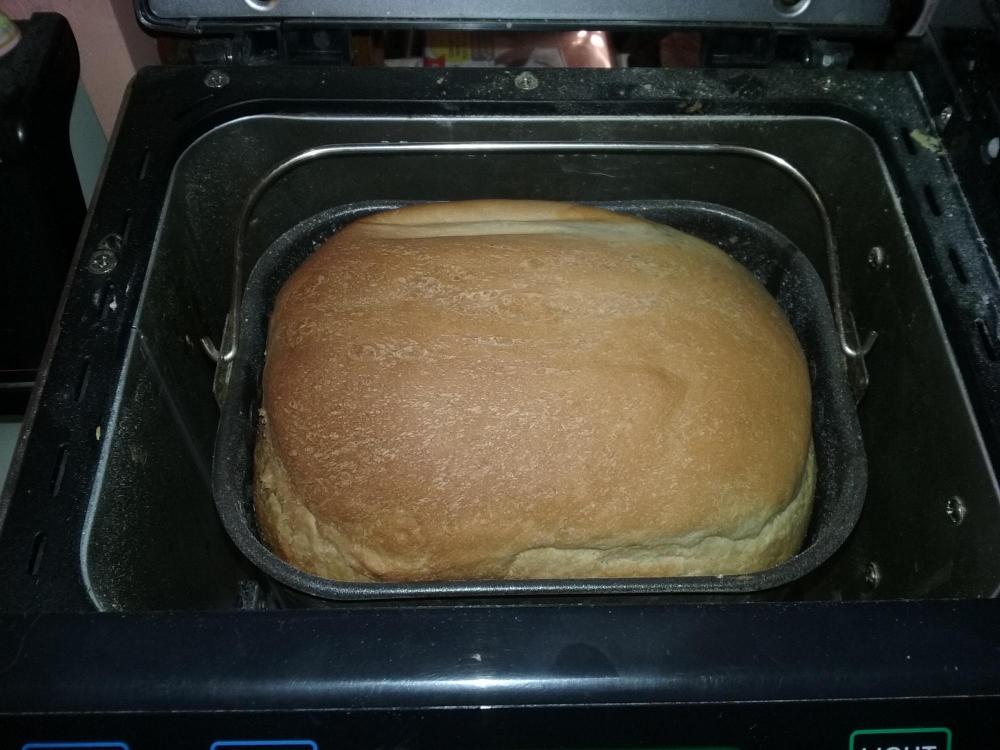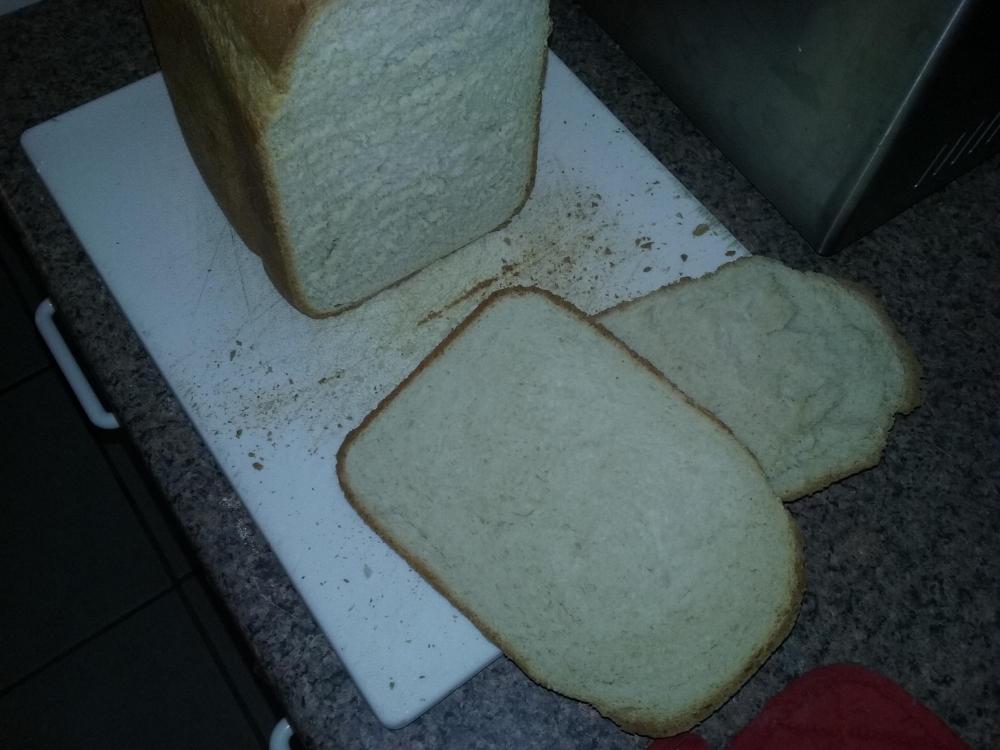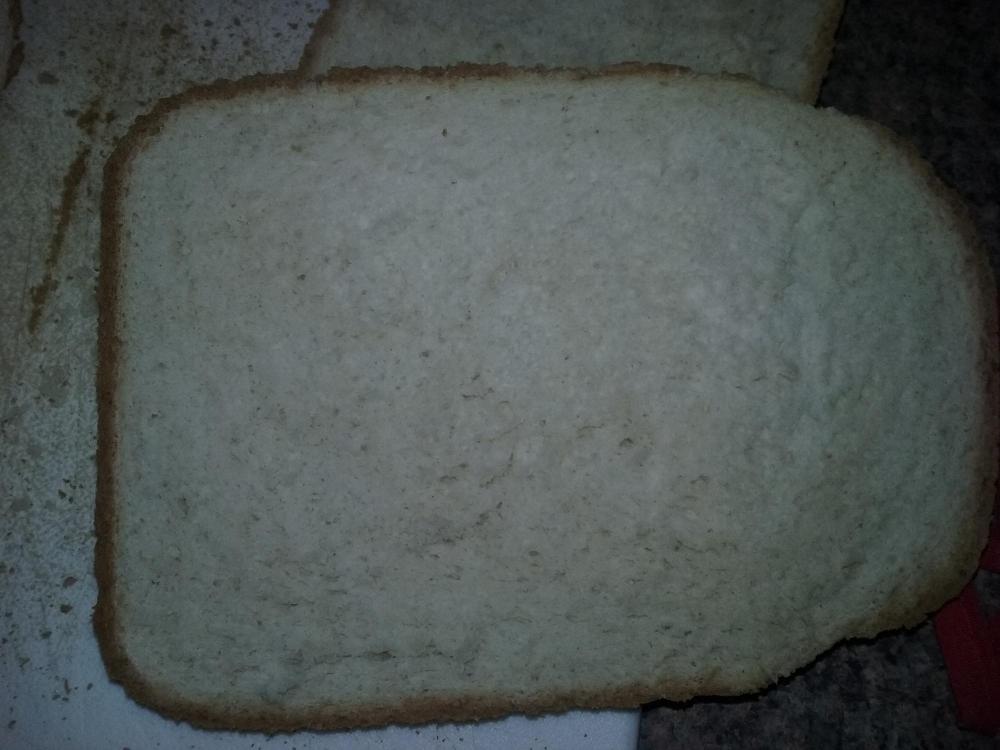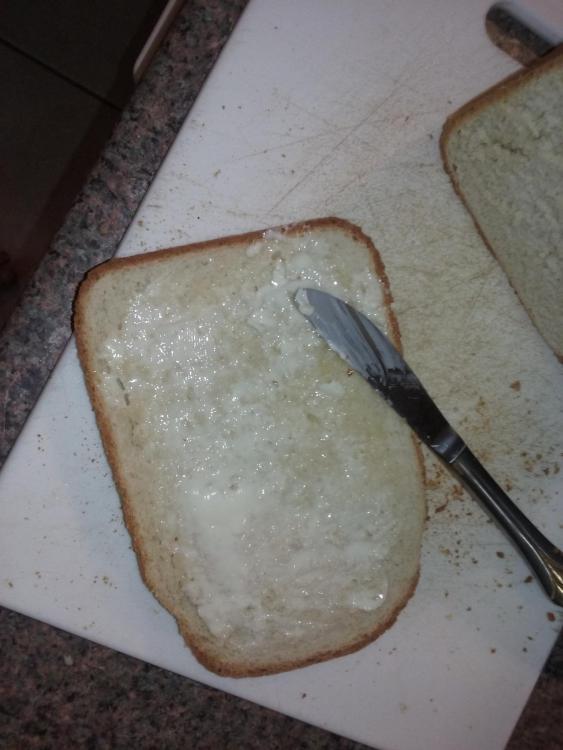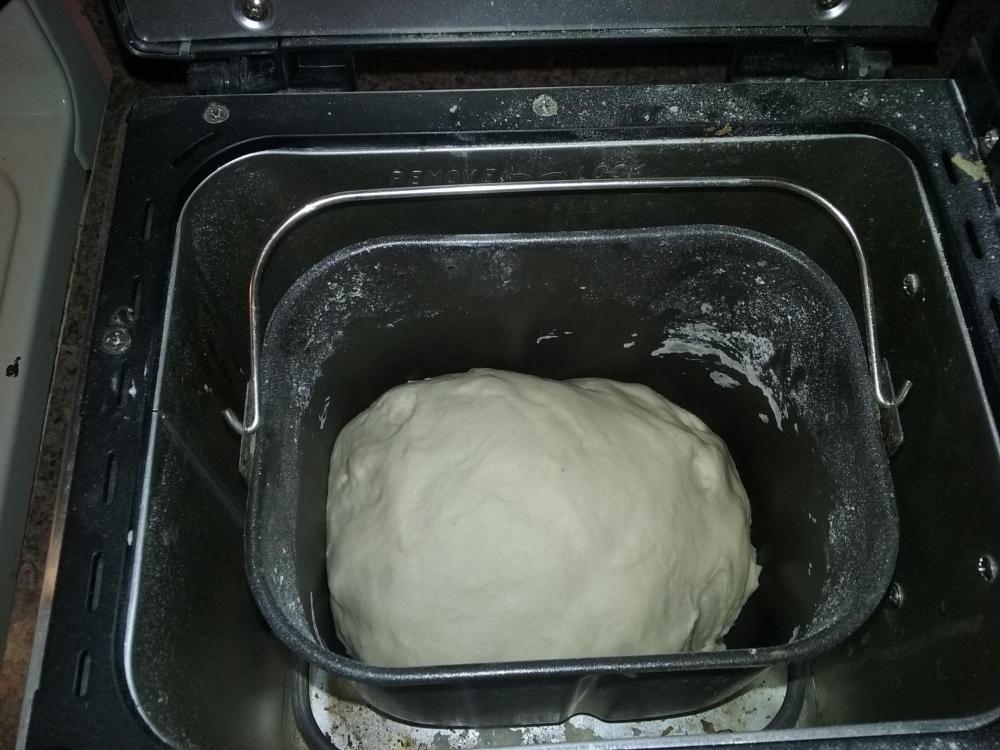
BarneyDorfman
participating member-
Posts
21 -
Joined
-
Last visited
Recent Profile Visitors
The recent visitors block is disabled and is not being shown to other users.
-
Right, well a re-read of the thread will show that what I'm doing has nothing to do with sourdough. My starter yeast/yeast starter/bowl of stinky brown goop is Fleischman's (commercial) yeast. Bread tastes great! (Not like that nasty sourdough stuff, yuck!) Back there a ways, someone said that giving the yeast more time to do whatever it does to the flour increases flavor. Being the eagle-eyed goal achiever that I am, I immediately noticed it and commemorated my awareness in the next post. Another Member here also noticed it and announced he was going to being experimentation immediately, which he did. Then reported back that the yeasties die off for some reason, and no report of any of the doomsayer's grim predictions of hoards of illegal "wild" yeasties invading my starter yeast in clear violation of immigration laws. But I stand at the ready, just in case. Can't really help with the reading comprehension issues, nor can I address specific questions that aren't being asked, mostly what I perceive are generalized complaints about a lack of clarity. Usually, when I have a question, I put some effort into understanding the thread, and then put some effort into asking a direct question, but that's usually because I have an interest in the topic of the thread and am interested in either learning something. I could be wrong, but that seems to be a prerequisite for learning things in general. You have to be interested enough in the subject to be willing to put some effort into it. Anyways, the experimentations continue. As mentioned previously, the "starter yeast/yeast starter/neverending gobstopper of yeast" is now more of a jello-like blob of dough than a bowl of oatmeal-like goop, and the primary reason for me doing this is because of that alcohol smell and someone previously said that the alcohol production of the yeast will kill those yeasties off, so maybe that's the reason for the "bowl 'o yeasties hospice care", IDK. My thinking is that if the flour/water/yeast mixture is on the dryer side, that might slow-down the growth of those yeastie-bugs and limit the alcohol and limit the population die-off due to alcohol poisoning. And I had the idea on the idea that "wild" yeast is going to sneak into my domestic yeast's country in the middle of the night when no one is looking and somehow "take over". I mean, if the starter yeast goes sour, then that's what happens, right. But I'm wondering why it is that a starter yeast that has a billion yeastie bugs in it, all multiplying like mad are suddenly going to get taken over by "wild" yeast. Are wild yeast tougher than commercial yeasts? I find it hard to believe that a couple of recently paroled illegal wild yeast immigrants are going to kill off billions of patriotic american commericial yeasties and take my starter yeast bowl over. But, if that happens, I might report it here. Maybe.
-
No, and in fact I was just finishing the last bite of a piece just as I noticed the "new post" notification. In rough figures, my recipe calls for about 12 oz. of water, and since I added a full cup of "starter" yeast, which was roughly half water and half flour, with a single t. of yeast (4 days ago), I decided that half my 1 c. of flour/water/yeast "starter" was water so I reduced my 12 oz. of water to 8 oz. Also threw in 2 of the worst bananas I've ever had. The bread is DELICIOUS. Heavy, like banana bread, but still light enough to be thought of as white bread, It has a light flavor of banana, but not so much that you think "desert" instead of "meal". In fact I ate the bread with a hot bowl of very hearty pinto bean and baked ham soup (with onion and a dash of garlic). Mention this in case anyone thinks that white bread with a couple bananas thrown in would be ruined as "main meal" bread. I think it makes the ham & bean soup taste better. As far as the starter yeast's performance, the 1 c. of "starter yeast" had enough active yeasties in there to make my bread raise to approximately the same height as usual. It was about 1/2" lower than what I normally get, and for sense of scale, when I add 2 t. of active yeast (instead of 1 t.), the 2.5 load raises so high it sticks to the lid of the bread maker. In short, in my recipe, 1 t. active yeast "good", and 2 t. active yeast "too much". Using just the "starter yeast" caused the bread to rise a little low compared to the standard 1. t. active yeast option, but I can't say what the non-standard water measurement plus the moisture from the 1 c. of "starter yeast", plus the effect of the 2 horribly flavorless (but still not brown and over-ripe) bananas. Lots of learning going on over here. Like I say, an ounce of action is worth a ton of theory. I added more flour and water to my dedicated rotten starter yeast tupperware container, but held back on the water to see what would happen if I kept the "starter yeast" more like "dough" and less like goop. I'll report results in a few days as I plan on making another loaf using the starter yeast alone and hopefully these remaining bananas will have found their way into the compost pile.
-
I threw some flour, yeast and water into a tupperware container and let it rot on the countertop for 4 days. It smells like alcohol now. I threw half of it into the batch of bread I made this morning and I'm wondering what's going to happen. An ounce of action is worth a ton of theory. I think the "purpose" of putting yeast into water and flour is to maximize whatever effect yeast has to increase flavor. Maybe some people that prepare food don't care much about flavor, as long as you weigh your ingredients and the end product is 100% consistent, then the purpose of food preparation has been fulfilled. pbear I appreciate your time, expertise and effort. I might report here if something interesting happens.
-
My wife likes crust, so she always gets the 1st piece, and I always get the 2nd. She wouldn't let me take a picture of hers. Said it was "weird" to have strangers looking at her food. This piece is mine. Note the heavy layer of butter. I hope that's okay. I'm certain that neither preppers nor beduins are allowed to have that much butter on their bread, and I'm certain my butter-slathering technique is probably all wrong. Perhaps someone could post a copy of a book that will instruct me on the right way to put butter on my bread? In seriousness, this loaf is the one that has only 1 t. of yeast, with a bloom time of overnight. The bread is less "poofy" than the last loaf, and has less flavor too, so when comparing the last two loaves: 1st loaf: 2 t. yeast, 2 T. flour, 1 1/2 c. warm water, bloom time 2 hours Result: much better texture, too much "poof", stuck to lid of machine, much better flavor 2nd loaf: 1 t. yeast, 3 T. flour, 1 1/2 c. warm water, bloom time overnight (@ 10 hours) Result: "grainier" texture, size/height was correct, less flavor than last loaf.
-
Some pics. #1 is my Chef Paul Prudhomme 2.5 lb. breadmaker, #2 are my current weights of ingredients in black magic marker on the side of the stainless steel of the bread maker (26.05 grams flour, 11.70 grams warm water, 1.85 grams sugar, and #3 is a picture of today's loaf, in the middle of the 2nd of three "Rise" periods.)
-
Yeah I keep hearing that a lot, and the most diplomatic response I have is that some people have reading comprehension issues, but they don't let that stop them from pontificating long in off-topic areas that have nothing to do with the topic of the thread, which is learning to apply the notion of "starter yeast" to the recipe that I've been developing for several weeks, and using in my bread machine. That's the topic of this thread. People that have the desire to help are welcome to do so. I thank those that have contributed thus far. AFAIC, "John Galt" is the guy back there that, once he understood what the thread was all about, he went immediately from "what's this?" to "I'm going to start experimenting immediately". THAT is the kind of person I hold in highest regard. An ounce of action is worth a pound of theory. And, as an update, I extended my bloom time to overnight, decreased the yeast to 1 t. and increased the flour to two T., it's in the bread machine right now. The last loaf had a bloom time of 2 hours with 2 t. yeast, 2T. flour and the flavor increase was significant, however the loaf "poofed" inside the machine to the point that it stuck to the lid and blocked the steam vent holes, so I decreased the amount of yeast while increasing the bloom time. I'll report results, maybe later this evening.
-
Okay so I've done quite a bit of learning during the course of this thread, and one of the primary things I've learned, which has taken some time to assimilate, is that there are different kinds of yeast, and in general they can be described as either "wild" or "sourdough" and "commercial". Tonight I spent some time looking at YouTube videos regarding sourdough starter yeasts, and did not find any that focus on commercial yeast, which given my aversion to the sourness of sourdough, may make my little project harder than it would otherwise be. (However as a side note I have also learned that there are varying degrees of sourness in "sourdough" bread, and that my last experience may be been with a particularly sour bread, and that I might be okay with sourdough as a general class, however as mentioned before this is all about my wife and what she likes). There are a bunch of YouTube videos discussing starter yeasts and they are exactly as I imagined them; bowls of brown glop. They take half out and use it, and "feed" the starter by adding more flour and water back in. However they are on baking schedules on the scale of once a week and I am baking once every 1 1/2 days. And also, one video mentioned something already mentioned in the thread, which is that the starter should be kept in the refrigerator, but again they were baking once a week. Another thing to think about is what impact the amount of starter has on flavor. Example if I add 1/2 c. of starter to my 4 2/3 c. recipe, how does that flavor compare to if I use 1 c. of starter and reduce my flour by a full cup? Working out the details before executing some experiments. I should start my starter yeast sometime tomorrow.
-
Well, I don't know what a "brioche" is (I just looked it up on Wikipedia, and this recipe has no eggs), but it's not sweet. My wife likes it, and we eat it every day, so by that standard, it's an "everyday" bread. Thanks, I appreciate that, but earlier in the thread someone else said that my standard 45 minute blooming time wasn't enough, and also when you consider that the exponential growth phase of yeast can be around 3 day, if the goal is to maximize the yeast population, then the bloom time should be longer and not shorter than my 45 minutes. Thanks, I'll look into that. There's more to it than just saving money. As mentioned before, I have a bit of the "prepper" in me. The idea of "starter yeast" has been around for a long time, since I think Sunday school when I learned the difference between leavened and unleavened bread and how nomadic jews (and other beduins) would keep a lump of "something" around in order to make leavened bread. I'm calling that thing "starter yeast". They made bread before Fleishman's started selling yeast in cans. Somehow. Maybe they walked five miles to school, uphill in both directions, carrying a burning Franklin stove with Aunt Mamie's bread baking in it, but they managed to bake bread before large factories started selling 4 lbs. of yeast on eBay for $16.00, and I'd like to learn how to do what they did, live, at least in some respect, like they lived. I don't like being dependent on things, and helpless. And, if there's a way to make bread using yeast that I didn't have to buy from Walmart, then I'd at least like to know that I could make it without buying yeast from Walmart, even if I'm making bread using the yeast I bought from Walmart. Just knowing I COULD do without that Walmart yeast might be enough for me. Or, it might not. You never know. I've seen this in other areas of life, where "everyone else" gets so locked-in to the standardized and formulated method for "living" that their universe becomes very small, and (worst) it's the exact same small universe as everyone else has. One day, I accidentally walked into a place called "La Madeliene" and had some of what I thought was that silly, froo-froo "French Food", because you know on Hogan's Heros, that little fey "Le Beau" was always cooing and clutching himself going on & on in his effeminate manner about the delicate and nuanced flavors of French Food. The French, I concluded (I was young, were delicate, effeminate people that ate delicate and insubstantial food that only a highly evolved sophisticate could appreciate. La Madeliene served me large portions of meat, and even larger portions of potatos, with salt, pepper, onion and ALL the flavors that I loved. Turns out, French food is hearty, substantive stuff. "Rib Stickin' Food", and I had no clue. My universe was very small, thanks to that stupid show, Hogan's Heros. So yeah, I wanna charge out there into the great beyond, and let my yeast grow for 3 days and then toss that slop into my bread machine and see what comes out. What if my universe comes out much larger than I imagined it could be? And what if your universe, too, gets bigger, as a result?
-
Recipe is posted at the beginning of the thread. Also mentioned was that the bread machine is a 2.5 lb. "Chef Paul Prudhomme" stainless steel machine. The first one died after about the 10th loaf, and it was a major hassle getting the warranty replacement, so even though the 2nd one produces good loaves that are very consistent (now that I'm weighing most of my ingredients), I still don't "love" it, because I don't trust it. Maybe in a year, if it maintains it's performance, I'll give the machine a ringing endorsement, but right now I'm cynical, and waiting for it to fail again. However, on the up-side, it has a built-in electronic scale. I'll post a pic of the machine as well. Next loaf I make, I'll post pictures. I'm not trained in baking, so my opinion is going to be more layman-y, but I have a strong vocabulary, so to the question of texture/crumb, it's a bit crumbly, but not extreme. When the bread knife goes through it, there's a decent pile of crumbs at the bottom of the cut, and throwing them away is a routine chore everytime I clean the kitchen counter. It's not WonderBread. It's not what I would call sweet, but that's what I'm aiming for. I want it to be just on the underside of sweet. Wherever that threshold is where most people would say they could taste sugar, I want to be 1 or 2 T. sugar less than that. Recipe is still under development, but right now I'm focused on consistency, practicing weighing my ingredients (totally new to me), I want a moist, buttery loaf. Mostly this whole thing is for my wife. To me, bread is what you make sandwiches out of. It's the stuff that keeps you from getting the grease from the meat on your fingers. However, my wife has fond memories of her now deceased aunt making fresh bread, and so in my household, making the bread is more for her than it is for me. And she has a sweet tooth the size of King Kong, and likes butter. Butter in the bread, butter ON the bread, and washed down with a nice mug of warm butter, with extra sugar.
-
Alright well this answers one questions and creates another. The idea that yeasts produce enzyme is new to me, so thanks for that. Applied bread science. But then it seems to me that the the "sponge" thing is to break down a percentage of the flour, but not all of it, for purposes of flavor, and not so much to grow yeast, which is what I'm aiming for. Why put it in the refrigerator? The sponge can break down flour and grow yeast both at room temperature. But again the best part is the yeast growth rate, because that gives me something to think about when "blooming" my yeast. I've been dumping it in after about 45 minutes, which means that my yeast population has only been given enough time to increase by 50%. Now I want to know what the upper-end of what I assume is a Bell Curve looks like. i.e. What happens after 3 hours? 6 hours? 12 hours? etc...
-
Okay so you are luring me in with the sexy promise of a "bunch of extra flavOr" , but like rotuts alluded to, there's the time & hassle factor to consider. But then, there's the promise of "a bunch of extra flavor", so... hmm.... How much "extra flavor"? So thanks for the suggestion of a "sponge" although I don't see a connection between that word and the mechanics of the suggestion. Also you included the word "yeast" in the list of ingredients that get "thrown in" to the bread machine the next day. I assume mentally you were just running down the list without considering that we just spent 12+ hours growing all the yeast a person could possibly want in the refrigerator. Do we add yeast after growing a "sponge"? I'm going to try this suggestion, just to know how much "extra flavor" is involved here. But for daily, routine purposes I need a method to produce a loaf of bread every 1 or 2 days, that doesn't require me to use 2 t. of yeast every day, when I could "grow my own" instead. Although I'm also getting the idea that 4 lbs. of yeast from eBay is going to be the easiest way to have long-term yeast, but since the whole point of the thread was to explore a workable method (for me) to make and continue to use "starter yeast" for my daily bread-machine produced bread, I'd like to at least complete the purpose of the thread, i.e. get a workable method of daily "starter yeast" and make bread with it for (maybe a week) before I (probably) decide it's not worth the hassle and drop $20.00 on 4 lbs. of yeast, which (doing calculations now...) Here's an online "pounds of yeast to teaspoons" converter I just found: http://www.traditionaloven.com/culinary-arts/baking/dry-yeast/convert-pound-lb-to-tea-spoon-tsp.html Which says I get 640 teaspoons from 4 lbs. of yeast. At 2 t. per loaf and a loaf every 1.5 days, 4 lbs yeast = 640 t. yeast / 2 t. X 1.5 days = 480 days / 365 days in a year = 1.3 years worth of yeast, at the rate I am currently making it. For $20.00. GOD I LOVE the internet. Who would have thought that someone online would go to the trouble of making a "pounds of yeast to teaspoons of yeast" converter???? Anyways, those are my variables, and my thoughts. Probably not worth the hassle of doing "starter yeast" in order to save less than $20.00 a year, but part of my identity is to make what I need to the greatest extent possible. I have a strong streak of "prepper" in me, and even if I don't actually do it day in and day out, I'd like to at least know that, if necessary, I could make a "go" of things without relying on a daily supply of yeast. So, with all that said, I assume that there will some variation on the "sponge" method in order to use half the "sponge" for today's bread, add more water and flour for tomorrow's bread. Is this something I'm just going to have to figure out on my own? Can someone give me a rough idea to start with?
-
Okay so today I'm ready to talk about this "Starter Yeast" thing. How to do, what to do, etc... My recipe uses 1 1/2 c. water and 2 t. yeast. I add 1 t. sugar and 1 T flour to my warm water and let it "bloom" for about an hour before dumping it in. How to I translate this method to using "Starter Yeast"?
-
Thanks for all the replies. I don't have a Costco membership and this is the 2nd time in a week someone has given me a reason to get one. (The other reason was cheap pet treats.) 55 Dollars for the privilege of giving someone my money is totally counter intuitive to my nature. They should be paying ME to walk in the door. Been shopping for yeast and once you add in the shipping charges, my deal at eBay is still the best one. 2 - 2 lb. bags for less than $20.00. Not sure if I'll ever use 4 lbs. of yeast, but for $20.00, knowing that I'll never need to worry about buying it again seems like a good deal to me. I've started weighing my flour, and next will be my water. Don't think I'm going to be so fussy as to weigh anything else, since the flour and the water are the two big ones and it's the ratio between the two that has the most impact on what you get at the end of the process. New thing I did on accident last week I thought I'd share. Two bananas too ripe to be enjoyable to eat got thrown into the bread maker on a whim and what came out wasn't "banana bread", but it wasn't horrible either. Somewhat sweeter than standard white bread, a little heavier and denser, with a light and not unpleasant "banana" flavor. It was a good way to avoid having to condemn 2 perfectly good bananas to the compost pile.
-
So I've taken the advice and measured my flour today. Recipe calls for 4 2/3 c. and what I measured-out weighed 26.05 oz. Now I see why my bread maker has a scale attached to it. At first I thought it was stupid. After all, who uses a scale to measure things like flour? Also threw a couple Tablespoons of flour into the 1 1/2 c. warm water, along with the 1 t. of sugar, in order to "bloom" my yeast better. And I'm going to give it an hour to bloom, instead of the previous 1/2 hour. Next I suppose I'm going to need to by a food thermometer so I can control for the temperature of the water. I wonder if I can buy bulk sized yeast on eBay? That seems like the obvious place to get it. EDIT*** Found this: It looks like the best deal, in terms of price and distance (I prefer US only, and the closest to Texas the better.), in case anyone has an opinion on this specific product, and vendor. I'll hold off buying until the end of the day.
-
I try to spend as little as possible on meat/protein, and I'm a big fat of "picnic pork shoulder roasts" (whatever the correct word is) that sell for @ 1.50/lb. Bought one two days ago at the local grocery. It was about 11 lbs. for about $18.00 and came packaged in a vaccum-sealed plastic bag, and had the name-brand "Tyson" on it. Left it sit on the kitchen counter overnight on accident, and put it in the oven the next morning. Figured that since it started out refrigerated it was still good the next morning. Didn't smell when I took it out of the bag, no air bubbles in the plastic that might have indicated decomposition. Placed it in a kitchen roasting pan with a lid and about 2" of water to keep it from scorching, and since it's going to be shredded down for pulled-pork sandwiches (salt, pepper, BBQ sauce, etc...) didn't bother to season it at all. Pork roast, water and roasting pan. In the oven at 350 deg. for 4 hours. and it smelled good when I pulled it out but when I cut into it and started removing the heavy layer of fat & skin from one side, the unmistakable and heavy odor of ammonia, mixed with the steamy hot pork odors. Truly disgusting. I figured, correctly, that if I let it rest for a few hours it would "air out" and taste fine, and so I did and it does. But today I'm wondering what the stink was all about, if it was normal, and whether or not it was safe. The fact that the per-pound price is so low ($1.50) makes me wonder if I have some kind of geriatric pig meat (one of my theories on why chicken breasts are so cheap is that they are egg-layers that are too old to lay eggs, so I wonder if cheap pork isn't cheap for the same reason). Or what. Smelling ammonia on a freshly-baked pork roast isn't normal, is it?


